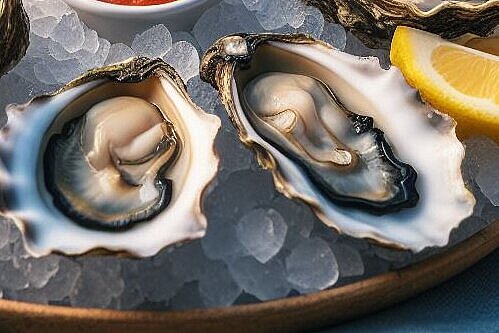Seafood

What is seafood?
Seafood is any animal that lives in the sea and is edible, but is not a fish. This includes, for example, mussels, prawns, crabs, lobsters and squid. Seafood has a high content of protein, minerals and omega-3 fatty acids, which are important for dogs' health. They are also usually low in fat and easy to digest.
Which seafood can dogs eat?
Not all seafood is suitable or tolerated by dogs. Some can even be poisonous or cause allergies. That's why you should always do your research before offering your dog seafood. Here are some examples of seafood that dogs are allowed to eat:
- Mussels: Mussels are rich in B-group vitamins, vitamins C and E, iron, magnesium, calcium, potassium, phosphorus and sodium. They can be fed raw or cooked, but only the meat inside the shell. The shells are not edible and can have sharp edges that can injure the dog. You should also make sure that the mussels are fresh and not contaminated with environmental toxins or algae toxins. One particular type of mussel is the green mussel, which is available as a powder and can help to support joint health.
- Prawns: Shrimp is also a good source of protein, omega-3 fatty acids and antioxidants. They can be fed cooked or raw, but without the shell and gut. The shell can cause constipation and the gut may contain bacteria. Prawns should only be fed in moderation as they contain high levels of iodine, which can affect thyroid function.
- Crabs: Crabs have a similar nutritional value to prawns and can also be given raw or cooked. The same applies here: feed without shell and gut and not too often due to the high iodine content.
- Lobster: Lobster is an expensive delicacy that you can treat your dog to from time to time. Lobster contains a lot of protein, omega-3 fatty acids and zinc. It should be fed cooked and without the shell. Be careful not to feed lobster that has been prepared with spices or sauces, as these can be harmful to your dog.
- Squid: Squid are also rich in protein, omega-3 fatty acids and copper. They can be fed raw or cooked, but without the ink or beak. The ink can cause stains and the beak is hard and can injure the dog.
What seafood should dogs not eat?
There are some seafoods that you should avoid giving your dog because they are either poisonous or can cause allergies. Here are some examples:
- Oysters: Oysters are considered allergens and can cause gastrointestinal discomfort, skin rashes or respiratory problems in dogs. Oysters can also be contaminated with bacteria or viruses, which can lead to serious infections. Oysters should therefore not be fed to dogs.
- Tuna: Although tuna is a fish and not a seafood, it should still be fed with caution. Tuna can be contaminated with mercury or histamine, which can lead to symptoms of poisoning or allergic reactions. Tuna should therefore only be fed in small quantities and not too often.
- Rays: Rays are also fish, but they belong to the cartilaginous fish family. They have a high uric acid content, which can lead to gout in dogs. Therefore, rays should not be fed to dogs.
How do I prepare seafood for dogs?
If you want to feed your dog seafood, there are a few points you should bear in mind to ensure your dog's health and safety:
- Only buy fresh and high quality seafood from trusted sources. Avoid seafood that has an unpleasant odor or has been stored for a long time.
- Remove any shells, intestines, beaks or other inedible parts from the seafood. These may be sharp or contain bacteria that can injure or sicken your dog.
- Boil the seafood thoroughly to kill any germs or parasites. You can also feed the seafood raw if you are sure it is fresh and clean. However, make sure that you don't use any spices or sauces that could be harmful to your dog.
- Feed the seafood in small pieces and in moderation. Too much seafood can lead to diarrhea, vomiting or other digestive problems. It can also upset your dog's iodine or sodium balance. As a rule of thumb, seafood should not make up more than 10% of your dog's daily calorie intake.
- Monitor your dog after feeding seafood for possible signs of intolerance or allergy. These include, for example, itching, skin rash, sneezing, coughing, difficulty breathing or swelling of the face.
Seafood can be a healthy and tasty addition to a dog's diet if it is selected and prepared correctly. They provide valuable nutrients such as protein, omega-3 fatty acids and minerals, which are important for dogs' health. However, not all seafood is suitable or tolerated by dogs. You should therefore always find out which seafood you can and cannot feed your dog. You should also feed seafood in small quantities and not too often to avoid possible digestive problems or poisoning. If you keep these points in mind, you can give your dog a culinary treat every now and then.
If you notice any signs of hypersensitivity or poisoning in your dog, you should see your vet immediately. We are not a substitute for a vet, but we try to be as accurate as possible. Every dog reacts differently and we recommend you get a second opinion or consult your vet if in doubt.
Stay healthy and take good care of your four-legged friend!😊
Similar to Seafood
Prawns are rich in protein, which is important for your dog's muscle development and health. They also contain many vitamins and minerals such as vitamin B12, zinc, selenium and iodine, which...
Mussel meat is the soft tissue that lives inside mussels. There are many different types of mussels that can be used as food, such as mussels, oysters or scallops. Mussel meat contains a lot of...
Crabs belong to the decapod crustacean family and are known for their nutrient-rich body structure. They are a popular source of protein and are used in a variety of dishes around the world. As well...
Oysters are a type of seafood that belong to the shellfish family. They live in salty waters, especially in bays and estuaries, and are known to feed on nutrients dissolved in the water and...



